 Jacob Huckle, teacher and researcher in multilingual learning, shares his idea of translanguaging routines
Jacob Huckle, teacher and researcher in multilingual learning, shares his idea of translanguaging routines
In our latest post, we saw how some very little acts can be important to start making space for multilingualism and multilingual thinking. Jacob provides us with some practical suggestions on how to include our pupils’ whole linguistic repertoires in our classrooms through instructional routines.
More and more teachers and school leaders are coming to understand the importance of students’ home languages as resources for learning. How can we build upon this momentum so that all teachers are equipped to effectively leverage students’ languages? How can we support teachers to intentionally implement translanguaging pedagogies in their classrooms?
Translanguaging is beneficial for multilingual learners not only academically (Hillcrest, 2021), but also as a means to affirm students’ identities (Lin & He, 2017: 228; Yilmaz, 2019: 211) and ‘create spaces that students experience as empowering, adaptable, relevant and reflective of their own life experiences’ (Cioè-Peña and Snell, 2015). To maximise these benefits, we should make space for both spontaneous and pedagogical translanguaging in our classrooms:
‘Spontaneous translanguaging refers to the discursive practice of multilingual speakers that have not been planned by the teacher and which take place both at school and outside school. Pedagogical translanguaging refers to pedagogical strategies planned by the teacher inside the classroom’ (Cenoz, Santos, and Gorter, 2022).
A report by Smith et. al. (2017) proposes a conceptual model of three possible levels of teachers’ engagement with translanguaging: allowing, encouraging, and enabling.
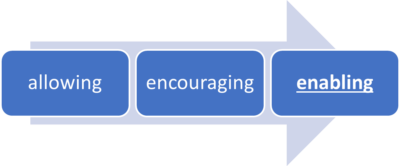
Teachers might make ‘translanguaging allowable in class’ by accepting multilingual languaging as normal (Smith et. al, 2017: 17). They go further than this when they provide ‘positive encouragement for pupils’ translanguaging’, appreciating the ways it supports their learning and identity development (Smith et. al, 2017: 17). But to truly leverage the potential of pedagogical translanguaging, we should go beyond allowing and encouraging to create ways of enabling translanguaging through our learning design. When translanguaging is enabled, teachers make intentional decisions to design activities, lessons, and units that actively draw upon students’ whole linguistic repertoires as part of the learning process. In other words, ‘translanguaging pedagogies should be purposeful and strategic, designed to support student learning and metalinguistic awareness’ (Hamman, Beck & Donaldson, 2018).
In my presentation at the 2021 NALDIC 29 conference, I argued that one way we might help teachers make this shift towards intentionally enabling students’ translanguaging is through routines for translanguaging and multilingual thinking. I am using this term to refer to instructional routines – ‘structured activities that occur repeatedly within the classroom’ (Litt et. al., 2015: 163) and ‘help teachers and students know what to do next in instruction’ (Tobias & Duffy, 2009: 64) – that embed students’ use of their whole linguistic repertoires.
Instructional routines can be an effective way of shifting teacher practice and students’ learning habits. They are popular with teachers because ‘they require less preparation that new lesson plans, and evidence-based strategies are right at their finger-tips when needed’ (Gibbons et. al., 2019: 122). For students, instructional routines create a ‘supportive, predictable learning environment’ and ‘benefit [them] because of their consistency’ (SanGiovanni, 2020: 108). Embedding translanguaging into instructional routines makes it more actionable for teachers and is a way towards designing multilingualism into the pedagogical fabric of our schools.
In the last few years, I’ve been creating and experimenting with various routines for translanguaging and multilingual thinking in my own EAL classroom. From the common ‘Think, Pair, Share’ instructional routine, for example, I have created ‘Think, Pair, Prepare, Share’.
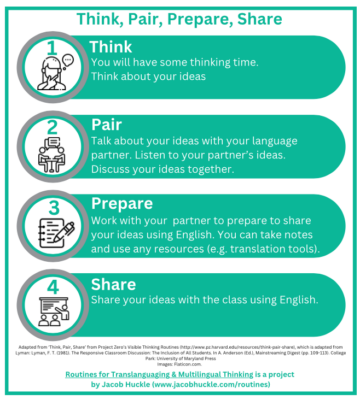
In this routine, students think about their ideas, discuss them with a partner in their home language, work with their partner to prepare to speak about their ideas in English, and finally share with the class in English.
As another example, I use the ‘Multilingual Research’ routine to structure students’ research in multiple languages, helping them make connections between and reflect on information gathered in their different languages.
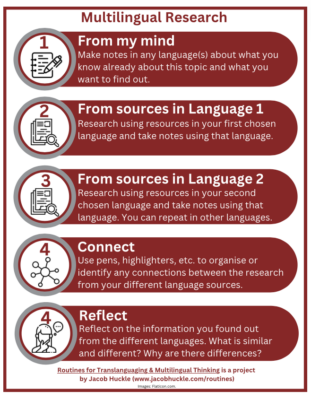
Routines like ‘I Say, I Say, Compare’ foster multilingual thinking as students reflect on similarities and differences between what they write in different languages.
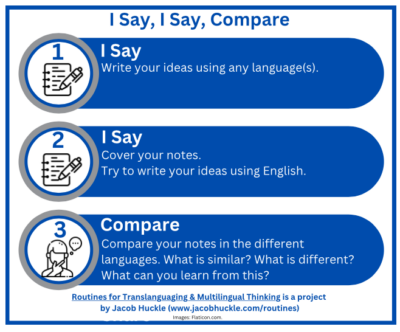
I have created routines like ‘Think, Share, Think Again’ to structure collaboration in mixed language groups.
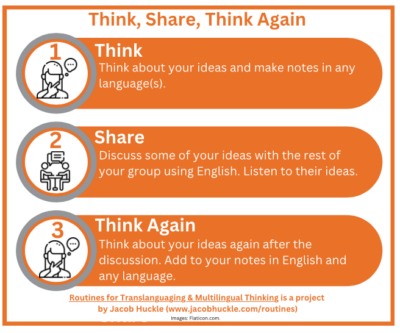
Through using routines like these, students and teachers can come to appreciate the value of pedagogical translanguaging and understand how all languages can be intentionally leveraged as part of the learning process. Routines can act as starting points for teachers to go on to consider other ways they might intentionally design learning to enable translanguaging, creating more inclusive and equitable classrooms that draw upon linguistic diversity as a valuable resource.
References
Cenoz, J., Santos, A., & Gorter, D. (2022). Pedagogical translanguaging and teachers’ perceptions of anxiety. International Journal of Bilingual Education and Bilingualism, 1-12.
Cioè-Peña M and Snell T. (2015) Translanguaging for Social Justice. Theory, Research, and Action in Urban Education IV.
Hamman, L., Beck, E. & Donaldson, A. A Pedagogy of Translanguaging. Language Magazine https://www.languagemagazine.com/2018/09/10/a-pedagogy-of-translanguaging/
Hillcrest, D. (2021). Academic benefit of translanguaging. MinneTESOL Journal 37(2).
Gibbons, K., Brown, S., & Niebling, B.C. (2019), Effective Universal Instruction (London: Guildford Press)
Lin, A.M.Y & He, P. (2017). Translanguaging as Dynamic Activity Flows in CLIL Classrooms. Journal of Language, Identity & Education 16(4), 228–244.
Litt, D., Martin, S.D., & Place, N.A. (2015), Literacy Teacher Education: Principles and Effective Practice (London: Guidford Press)
SanGiovanni, J.J., Katt, S., Dykema, K.J. (2020), Productive Math Struggle (London: Corwin)
Smith, H., Robertson, L. Auger, N., Azaoui, B., Dervin, D., Gal, N., Layne, H. and L. Wysocki (on behalf of the ROMtels team) (2017). A Pedagogy for bi/plurilingual pupils: Translanguaging.
Tobias, S. & Duffy, T.M. (2009), Constructivist Instruction: Success or Failure? (New York: Routledge)
Yilmaz, T. (2021). Translanguaging as a pedagogy for equity of language minoritized students. International Journal of Multilingualism 18(3), 435–454.
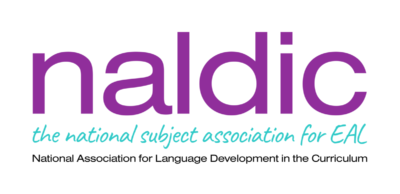
Do you have a story to tell us about translanguaging in your classroom?
- Join one of our Regional or Special Interest Groups
- Attend one of our free NALDIC events this year
- Write a post for the NALDIC blog –get in touch


